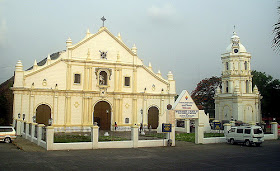Inang Baket always have problems with her stomach. She will have two operations and it would be the cause of her death. It started just after the big war when her stomach suddenly started bulging and she became sickly. Nobody can cure her in the entire province of Nueva Vizcaya Sur.
They found Dr. Godofredo Reyes in Vigan, Ilocos Sur but they have no money to pay for the operation. Amang Lakay pleaded for the doctor to operate on Inang Baket. He promised to pay upon receiving the money from the sale of his carabao. Dr. Reyes agreed but there are no available anesthesia. Inang Baket had to endure every slice of the scalpel on her skin, and she passed out in pain when the knife began scrapping a tumor from her stomach which caused it to bulge. When she regained consciousness, the pain came back and stayed for weeks. She is lucky to survive. Dr. Reyes' five other patients with a similar case died after being operated. The good doctor will later serve as Ilocos Sur Governor.
They found Dr. Godofredo Reyes in Vigan, Ilocos Sur but they have no money to pay for the operation. Amang Lakay pleaded for the doctor to operate on Inang Baket. He promised to pay upon receiving the money from the sale of his carabao. Dr. Reyes agreed but there are no available anesthesia. Inang Baket had to endure every slice of the scalpel on her skin, and she passed out in pain when the knife began scrapping a tumor from her stomach which caused it to bulge. When she regained consciousness, the pain came back and stayed for weeks. She is lucky to survive. Dr. Reyes' five other patients with a similar case died after being operated. The good doctor will later serve as Ilocos Sur Governor.
They stayed for three months in Vigan while Inang Baket recuperates from the operation. They finally came home hitching a ride on a logging truck. The trip almost killed Inang Baket. She looked like death --- frighteningly thin, her mournful but soothing eyes dull with pain. But she would live for a long, long time.
Vigan is one of the oldest pueblos in the Philippines

I always make a stop in Vigan whenever I have the chance. It is my way of saying thank you to the miracle and kindness of Doctor Reyes, and for another moment of basking in the well-preserved Ilocano heritage city. I took Bulan in my last trip to the Ilocos and told him the story of the miracle while walking around Vigan’s heritage district so he will not forget. We had a photo in the statue of the great Ilocana poet Leona Florentino.

Vigan is along a loop that includes the towns of San Vicente,Santa Catalina , and Caoayan. These 3 other towns are part of Metro Vigan and their magnificent colonial churches --- perhaps built by the Domincans --- is worth a brief visita iglesia.




I always make a stop in Vigan whenever I have the chance. It is my way of saying thank you to the miracle and kindness of Doctor Reyes, and for another moment of basking in the well-preserved Ilocano heritage city. I took Bulan in my last trip to the Ilocos and told him the story of the miracle while walking around Vigan’s heritage district so he will not forget. We had a photo in the statue of the great Ilocana poet Leona Florentino.

Vigan is along a loop that includes the towns of San Vicente,



Pedro Bucaneg's Mountain
The town of Bantay
Bantay was accepted by the Augustinians as a mission in 1591. Its church (dedicated to San Agustin) was also said to be the recipient of miracles through the intercession of the enshrined image of the Our Lady of Charity: during Malong’s Revolt in 1661 and Silang’s Revolt from 1761 to 1763 when the parochial building s were spared from a fiery destruction. During the Silang Revolt, the convent was used in imprisoning Bishop Ustariz and some priests until they were released after Diego Silang’s assassination by Miguel Vicos. The present church might have been the one that Fr. Eduardo Navarro had initiated to rebuild in 1870. Some years later in 1928, the ivory parts of the image of Our Lady of Charity were stolen and never recovered.

PHOTOS (top to bottom): (1) The Vigan metropolitan cathedral; (2) Tatay and Bulan at the Leona Florentino monument; (3) San Vicente Church; (4) Sta. Catalina Church; (5) Caoayan Church; and (6) Bantay Church.

No comments:
Post a Comment